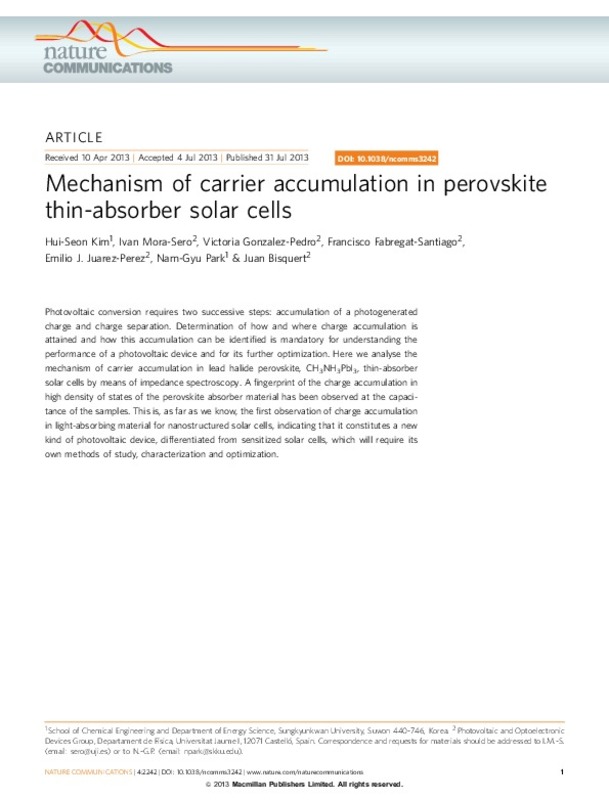Nozik, A. J. Quantum dot solar cells. Physica E 14, 115–200 (2002).
O'Regan, B. & Gratzel, M. A low-cost, high-efficiency solar-cell based on dye-sensitized colloidal TiO2 films. Nature 353, 737–740 (1991).
Hodes, G. Comparison of dye- and semiconductor-sensitized porous nanocrystalline liquid junction solar cells. J. Phys. Chem. C 112, 17778–17787 (2008).
[+]
Nozik, A. J. Quantum dot solar cells. Physica E 14, 115–200 (2002).
O'Regan, B. & Gratzel, M. A low-cost, high-efficiency solar-cell based on dye-sensitized colloidal TiO2 films. Nature 353, 737–740 (1991).
Hodes, G. Comparison of dye- and semiconductor-sensitized porous nanocrystalline liquid junction solar cells. J. Phys. Chem. C 112, 17778–17787 (2008).
Mora-Seró, I. & Bisquert, J. Breakthroughs in the development of semiconductor-sensitized solar cells. J. Phys. Chem. Lett. 1, 3046–3052 (2010).
Kim, H.-S. et al. Lead iodide perovskite sensitized all-solid-state submicron thin film mesoscopic solar cell with efficiency exceeding 9%. Sci. Rep. 2, 591 (2012).
Lee, M. M., Teuscher, J., Miyasaka, T., Murakami, T. N. & Snaith, H. J. Efficient hybrid solar cells based on meso-superstructured organometal halide perovskites. Science 338, 643–647 (2012).
Noh, J. H., Im, S. H., Heo, J. H., Mandal, T. N. & Seok, S. I. Chemical management for colorful, efficient, and stable inorganic–organic hybrid nanostructured solar cells. Nano. Lett. 13, 1764–1769 (2013).
Ball, J. M., Lee, M. M., Hey, A. & Snaith, H. Low-temperature processed mesosuperstructured to thin-film perovskite solar cells. Energy Environ. Sci. 6, 1739–1743 (2013).
Edri, E., Kirmayer, S., Cahen, D. & Hodes, G. High open-circuit voltage solar cells based on organic–inorganic lead bromide perovskite. J. Chem. Phys. Lett. 4, 897–902 (2013).
Im, J.-H., Lee, C.-R., Lee, J.-W., Park, S.-W. & Park, N.-G. 6.5% efficient perovskite quantum-dot-sensitized solar cell. Nanoscale 3, 4088–4093 (2011).
Kojima, A., Teshima, K., Shirai, Y. & Miyasaka, T. Organometal halide perovskites as visible-light sensitizers for photovoltaic cells. J. Am. Chem. Soc. 131, 6050–6051 (2009).
Etgar, L. et al. Mesoscopic CH3NH3PbI3/TiO2 heterojunction solar cells. J. Am. Chem. Soc. 134, 17396–17399 (2012).
Hod, I. et al. Dye versus quantum dots in sensitized solar cells: participation of quantum dot absorber in the recombination process. J. Phys. Chem. Lett. 2, 3032–3035 (2011).
Boix, P. P. et al. From flat to nanostructured photovoltaics: balance between thickness of the absorber and charge screening in sensitized solar cells. ACS Nano 6, 873–880 (2012).
Unger, E. L. et al. Bilayer hybrid solar cells based on triphenylamine-thienylenevinylene dye and TiO2 . J. Phys. Chem. C 114, 11659–11664 (2010).
Palomares, E., Clifford, J. N., Haque, S. A., Lutz, T. & Durrant, J. R. Control of charge recombination dynamics in dye sensitized solar cells by the use of conformally deposited metal oxide blocking layers. J. Am. Chem. Soc. 125, 475–482 (2003).
Topoglidis, E., Campbell, C. J., Palomares, E. & Durrant, J. R. Photoelectrochemical study of Zn cytochrome-c immobilised on a nanoporous metal oxide electrode. Chem. Comm. 14, 1518–1519 (2002).
Bisquert, J. Chemical capacitance of nanostructured semiconductors: its origin and significance for nanocomposite solar cells. Phys. Chem. Chem. Phys. 5, 5360–5364 (2003).
Fabregat-Santiago, F., Garcia-Belmonte, G., Mora-Seró, I. & Bisquert, J. Characterization of nanostructured hybrid and organic solar cells by impedance spectroscopy. Phys. Chem. Chem. Phys. 13, 9083–9118 (2011).
Bisquert, J., Grätzel, M., Wang, Q. & Fabregat-Santiago, F. Three-channel transmission line impedance model for mesoscopic oxide electrodes functionalized with a conductive coating. J. Chem. Phys. B 110, 11284–11290 (2006).
Bisquert, J. Theory of the impedance of electron diffusion and recombination in a thin layer. J. Chem. Phys. B 106, 325–333 (2002).
Fabregat-Santiago, F. et al. Electron transport and recombination in solid-state dye solar cell with Spiro-OMeTAD as hole conductor. J. Am. Chem. Soc. 131, 558–562 (2009).
Dualeh, A., Moehl, T., Nazeeruddin, M. K. & Grätzel, M. Temperature dependence of transport properties of Spiro-MeOTAD as a hole transport material in solid-state dye-sensitized solar cells. ACS Nano 7, 2292–2301 (2013).
Fabregat-Santiago, F., Garcia-Belmonte, G., Bisquert, J., Bogdanoff, P. & Zaban, A. Mott-Schottky analysis of nanoporous semiconductor electrodes in the dielectric state deposited on SnO2(F) conducting substrates. J Electrochem. Soc. 150, E293–E298 (2002).
Kim, M.-J. et al. Unusual enhancement of photocurrent by incorporation of bronsted base thiourea into electrolyte of dye-sensitized solar cell. J. Chem. Phys. C 114, 19849–19852 (2010).
Ito, S. et al. Photovoltaic characterization of dye-sensitized solar cells: effect of device masking on conversion efficiency. Prog. Photovolt: Res. Appl. 14, 589–601 (2006).
[-]









